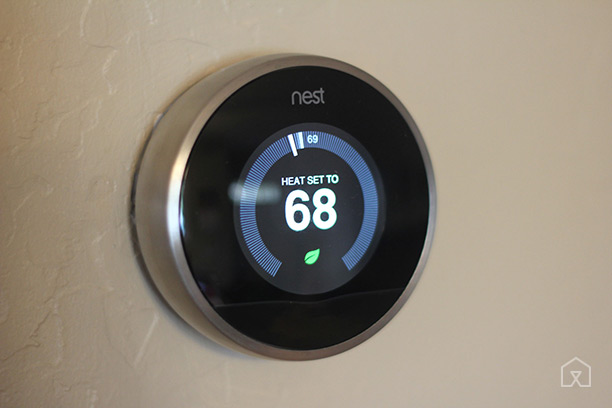

Three years after the Nest Learning Thermostat’s debut, the second-gen Nest continues to offer the best combination of style and substance of any thermostat. Its software and apps are solid and elegant, it learns your routines and the particulars of your house, and it’s easy to change the temperature from your phone or computer so you won’t have to get up from your cozy spot on the couch. It’s (still) the best smart thermostat for most people, though the competition is catching up.
Why a smart thermostat?
If you upgrade to any smart thermostat after years with a basic one, the first and most life-changing difference will be the ability to control it from your phone. No more getting up in the middle of the night to turn up the A/C. No dashing back into the house to lower the heat before you go on errands (or vacation). No coming home to a sweltering apartment—you just fire up the A/C when your airplane touches down.
The fact is, a cheap plastic thermostat with basic time programming—the kind we’ve had for two decades—will do a pretty good job at keeping your house at the right temperature without wasting a lot of money, as long as you put in the effort to program it. But that’s the thing: Most people don’t.
Get a smart thermostat if you’re interested in saving more energy and exerting more control over your home environment. If you like the prospect of turning on your heater when you’re on your way home from work or having your home’s temperature adjust intelligently without having to spend time programming a schedule, these devices will do the job. And if your thermostat is placed in a prominent place in your home, well, these devices just look cooler than those beige plastic rectangles of old.

Our pick: the Nest Learning Thermostat
The $250 second-generation Nest Learning Thermostat (introduced in 2012) is the leader of this category for a reason. Its learning mode automatically programs the thermostat based on your home and usage, its industrial design is the best, and it works with many other smart-home devices. The Nest offers the best combination of style and substance, and its software and apps are solid and elegant. It’s expensive, but Nest Labs claims the Nest can pay for itself in energy savings in as little as two years.
The Nest is striking, featuring a metallic ring with a black front and a circular LCD screen in the middle. The on-device interface is elegant, with every setting controlled by either a push on the face or a spin of the ring. The display shows red when heating, blue when cooling.
The Nest’s learning mode puts it above its competitors. It keeps track of how you adjust your thermostat over time, and it has an occupancy sensor that can tell when nobody’s around (in theory). The Nest can learn from your patterns and create its own schedule without any work from you.
The excellent Nest app (for iOS or Android) lets you program specific times and temperatures with a few taps. And Nest’s green leaf icon provides motivation to dial the temperature down just a little bit more in order to save energy. Unfortunately, the Nest doesn’t offer any external sensors to measure temperature in other rooms, and if it’s installed in a part of your house that doesn’t get much traffic, the occupancy sensor won’t be very useful.
Finally, Nest is owned by Google and seems to be the centerpiece of Google’s push into the smart-home ecosystem. If you plan on adding more smart devices to your home, the Works with Nest program means the Nest can integrate with a growing number of smart-home devices. Most of the interactions are gimmicky right now, but that won’t always be the case.
The next best thing (for larger homes)
If you have a large home with a single HVAC system, or you want to be able to measure the temperature in rooms other than wherever your thermostat happens to be, consider the $250 ecobee 3. It comes with a wireless remote sensor that monitors both temperature and occupancy, so it adjusts its settings to keep occupied rooms comfortable. It’s not as easy to use as the Nest, and its apps aren’t as stable, but it’s a better choice for people who want to be able to monitor the temperature in multiple rooms.
Wrapping it up
Despite its age, the second-generation Nest is still the best smart thermostat for most people. The hardware is excellent, and the software behind it is elegant and smart. And it works with a growing number of other smart-home devices. Competitors are hot on its heels, but for now the product that created this category is still its leader.
This guide may have been updated. To see the current recommendation, please go to TheWirecutter.com.
More Must-Reads from TIME
- Cybersecurity Experts Are Sounding the Alarm on DOGE
- Meet the 2025 Women of the Year
- The Harsh Truth About Disability Inclusion
- Why Do More Young Adults Have Cancer?
- Colman Domingo Leads With Radical Love
- How to Get Better at Doing Things Alone
- Michelle Zauner Stares Down the Darkness
Contact us at letters@time.com